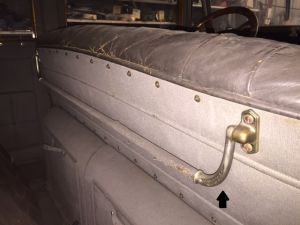- Home
- About Us
- Join/Renew
- Member Benefits
- Member Pages
- Log In
- Help
- Museum Store
Hi David,
Welcome!
Other people might want to chime in but you might have the top rest brackets under the front seat of the car. Pierce-Arrow really thought things through making provisions when the top was up and when it was down.
It sounds like your car might have the original “plugs” in the top down bracket holes. The top down brackets would be unscrewed and tucked under the seat or in a door compartment. This was another small detail Pierce-Arrow would do to make the lines of the body as clean as possible. When the top was to go down, the “plugs” were removed and the brackets installed.
Take a look in the compartments to see if they are still with the car. Not many cars still have both options but it was something that was done on a Series 33.
Also, check out the Library tab on the left side (above the Message Board) to see an owners manual of your car. It shows how “easy” it is to put the top down.
Have fun and enjoy your car.
Ben
Hi Jim and All,
Your password for this website, pierce-arrow.org, is safe. This website was NOT hacked. All user information on this website, pierce-arrow.org, is secure. In the 20-/+ years that this website, pierce-arrow.org, has been on the internet, the site has never been hacked nor information of our members compromised. Again, your current password for this site is safe and usable. There is no need to change your password. All passwords for all members are still usable and active.
The phishing email scam that was sent to our members was through a development website realted, but diffrent, to pierce-arrow.org. NO sensitive personal information has been compromised from that development website. The only information on the develolment site was names and emails, nothing more. The development website is an exploritory project to investigate ways to improve/update the current clubs website.
Thanks,
Ben Oakes
Hi David,
Thanks for posting this. Kinda sad to see this collection for sale. I too had the privilege of spending time around these cars, including the Pierce.
I was once told that of everything the owner drove the Pierce was often the favorite car.
Ben
I feel the best way to give you filter better filtration is to use a K&N Drycharger Filter Wrap. This is like a “bag” that goes over the outside of the filter area to provide more filtration. It would also ensure the integrity of the cage. You could clean the metal filter with cleaner then install this wrap on the outside of the unit to provide better filtration.
Here is a quick description of the Drycharger Filter Wrap:
“The filter’s location may expose it to unusually high levels of dust, tire spray, or even splashes of water. One way to help shield the filter from these elements is to use a DryCharger filter wrap.”
Wrap Type Drycharger
Color Black
Material Used Silicone Treated Polyester
Inside Diameter 7 in (178 mm)
Height 2.25 in (57 mm)
Closed Top No
The link below should be the correct dimensions for covering the outside of the metal air cleaner on your 1936 eight.
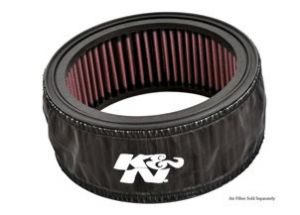
After looking closely at the metal cage/unit, it might not be a good idea to cut the tabs as that is the way the are held onto the unit.
You can see in the picture that the two nuts thread through onto the studs.
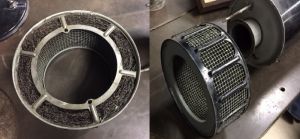
Hi Stu,
Interesting question about better filtration. I went out and took apart the one on the ’36 eight that is in the shop. After pulling everything apart I can see why K&N would not list such a filter.
Once you take the filter area apart you will see it looks like a Brillo pad that has been stuffed into a metal cage. If you were to cut each of the thin metal tabs, you could, maybe, stuff a filter into the unit.
After looking at the overall dimension of the metal cage, the filter would need to be a little shy of 7 inch’s in diameter and about 3 inch’s deep. I could not find anything that would fit this size….unless you want to cut down a filter.
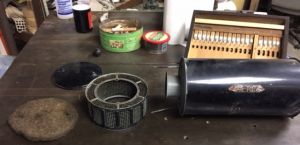
I tried posting this yesterday but kept having issues…must be the user.
Here is our 1934 1248 EDL profile picture for the comparison. Like the picture posted by Curtis, the radiator shell was painted recently by Wendell Shoberg to make the hood appear longer.
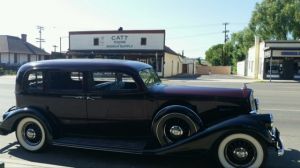
Here is a full view of the car
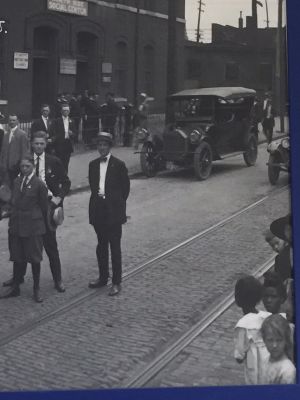
I saw this picture at the airport in St. Louis when I flew in for the 2017 PAS National Meet. Here are the pictures I took…
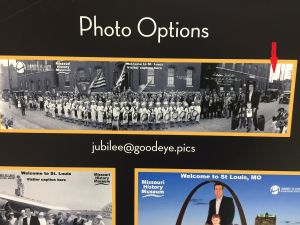
With the anticipation of this Optima Battery deal (Thank Your Peter) I have been looking into better ways to hold the battery(s) in the original space/compartment. I ran across this auction on eBay which might be a good solution for most. Often I have thought about trying to “dig out” or remove the internals of an old battery to fill in the area. This seems to be a much cleaner, safer way. This is a Group 2 size battery case.
Note: I have NO affiliation with this auction.
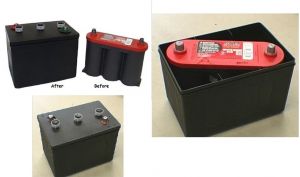
Hi Tony,
This comes up every so often. Here is a short video from Buffalo’s NBC affiliate that might help make a decision.
The following article is taken from the news article (WGRZ NBC):
“BUFFALO, NY – Nikola Tesla was certainly a genius. His work with alternating current, or AC power was groundbreaking, as was his partnership with George Westinghouse in harnessing the power of Niagara. But did he, decades later, also learn how to harness power right from the air, in the form of ambient or radiant energy?
As the story goes, Tesla came to Buffalo in the early 30’s and swapped out the combustion engine of a 1931 Pierce Arrow, replacing it with an 80 horsepower Westinghouse electric engine, then powered it with some sort of energy-gathering device that was positioned in the passenger seat.
Jim Sandoro, who owns and operates the Buffalo Transportation/Pierce-Arrow Museum, doubts the account to say the least.. “He supposedly came and went and bought some parts and made a small box with two levers on it, got in and said, here it goes, and took a ride and came back. It’s bologna. There’s never been one eye witness ever writing that they saw or heard anything about it.”
There are others who say it did happen. Apparently the story was relayed to a reporter by Peter Savo, who claimed to be Tesla’s nephew. This story has received some debate because no physical evidence has ever been produced confirming that the car actually existed. Tesla did not have a nephew by the name of Peter Savo, and Tesla’s grand-nephew William Terbo considers the Tesla electric car story to be a fabrication.
Sandoro says that one good thing has come out of what he calls “urban legend;” interest in Buffalo and the Pierce Arrow.”
This is a great promotion for both the Pierce-Arrow name and the organization.
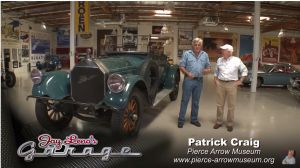
Hi Brooks,
I was incorrect about the death location of George N. Pierce. After looking at the information I have from The Automobile I was putting the Lenox hotel in San Antonio, Tex.
Sorry for the confusion.
Ben
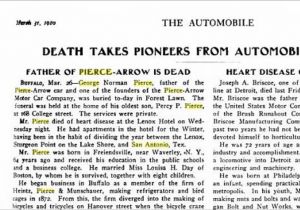
Hi Randy,
Unfortunately (or fortunately for the Geo. N. Pierce Company), these two men are not related.
Here is a quick overview of both.
George Norman Pierce
Born in Pennsylvania January 9, 1846
Died in San Antonio, TX March 23, 1910
George lived with his parents in the PA till 1870 when he moved to Buffalo, NY. Georges father, Henry Miller Pierce (born in England, 1790), fathered at least three extremely successful male children — James Pierronet Pierce was a railway and mining tycoon in California, George Norman Pierce was the manufacturer and inventor of the Pierce-Arrow, and Henry Miller Pierce (Jr.) had a very productive career as an educator and inventor. Frances married George Squiers, a very successful Buffalo businessman. George N. Pierce was one of 11 children.
Henry Clay Pierce
Born in Jefferson County, NY April 7, 1849
Died in New York City, NY June 27, 1927
Henry was the son of well-educated doctor from Upstate New York. In 1910 he was the second wealthiest man in St. Louis and the one of the richest men in the country. He marries the daughter of John R. Finlay who owned an oil company. Upon the death of his father-in-law in 1877, Henry made a partnership with William H. Waters. In 1878 J.D. Rockefeller bought the Waters-Pierce Oil Company making both men extremely rich. Shortly after, Henry Clay Pierce was found guilty of violating anti-trust laws through his relationship with Standard Oil. Waters-Pierce paid more than $1,700,000 in fines and interest.
https://www.findagrave.com/cgi-bin/fg.cgi?page=gr&GRid=21252
https://www.findagrave.com/cgi-bin/fg.cgi?page=gr&GRid=19547107
https://www.werelate.org/wiki/Person:Henry_Pierce_(5)
Ben Oakes
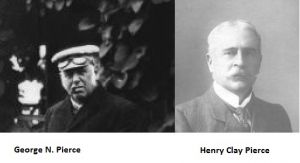
This picture shows a comparison to the Tonneau material from Haartz versus original tops of this era.
Note: I am sure there are other suppliers that have a similar grain for a tonneau cover in your area. This is just to show comparison of one brand to what would be original.
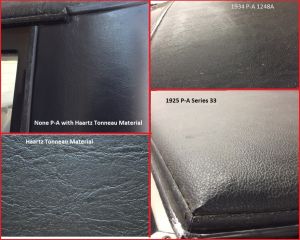
Hi All,
Doug, I had a similar issue with trying to find a nearly none existent (or light) grain for the top of a car like a Series 80. The issue I was finding was everything had a pronounced grain (long or short cobra grain) which was common on Ford and Dodge cars. If I looked at original tops of other cars of the ’20s, including Pierce-Arrow, I did not see a pronounced liner grain.
After calling around and talking to a lot of people in many clubs it was determined that I call Eric Haartz. Being young and naive I called the company front desk, told them who I was, and asked to speak with Eric. He was nice enough to take my call and gave a suggestion that became my solution.
His recommendation was to use a Tonneau material which has a very light grain. This material is 78″ to 84″ wide, weatherproof, and pliable enough to make corners easily. Luckily for a Series 80 you do not have to cover/pad the back window area. The grain (pictured below) shows a criss cross grain that is light and not liner. This has been a nearly perfect application for the car and does not distract from what the vehicle would of had originally.
This is what worked for me. I know that everyone’s experience is different but overall I could not be happier with the outcome. 7 years later the top still looks good while not distracting from the original look of the car
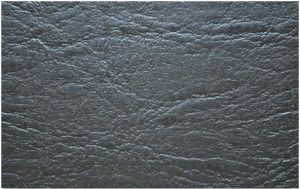
I have a question about the identification of a Pierce-Arrow that was used for BroAdmoor service.
Please correct me if I am wrong: I am of the understanding that the car number assigned by the BroAdmoor will be stamped on the top of the drivers-side parking light.
Has this been a consistent way to identify the car(s) or is there other items to look for?
Thanks,
Ben
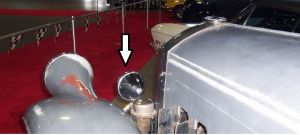
Hi Chris.
I was looking at the Stant part number that found and noticed that it is a 160 degree thermostat.
After living in Texas for 25 years, I am all about motors running cool!
That being said, you might want to increase the temperature of the thermostat to 180 degrees for better performance of the engine.
I too came across the need to change/replace the thermostat in our Series 33. To my surprise, a 195 degree had been installed years ago (..this would explain why we nearly always overheated when pulling long grades). After doing some research, the only Pierce-Arrow literature I could find that talked about the thermostat in a dual value six was for the Series 36. It stated to use a 180 degree.
The theory is the warmer the engine, the better the fuel with atomize through the carburetor and into the cylinder chamber giving a more complete explosion in each cylinder to maximize performance.
Interestingly for our car, the original type/style was discarded years ago. Somewhere in its survival a brass plate was fabricated which allows a modern thermostat to be soldered on. This is a nice feature as the price for this style thermostat is a few dollars and can be easily changed if there is a problem. Lastly, I drilled a small 1/8″ hole on the outside edge of the thermostat to allow a “by-pass” so there will always be some water the flows.
Our car is performing very well with the thermostat at 180 degrees. Plenty of power while watching the Motormeter rise and fall to the conditions of the road.
Enclosed is a picture to the front and back of the brass thermostat plate that was made for our car.
Ben Oakes
Ramona, CA
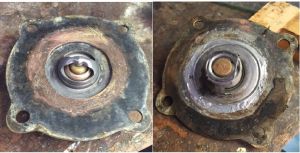
Here is another picture.
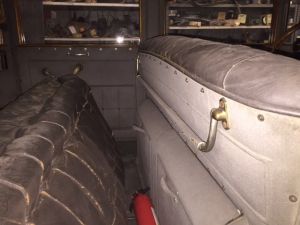
Hi Ed,
As I was running some errands I stopped by Billy’s Vintage and Customs in Ramona, CA. They personally have a original 1927 Series 36 7-Passenger sedan. Attached are the photos you need.
Measurements are as follows:
Robe Rail Unit (outside edge to outside edge) 39 7/8″
Robe Rail with Brackets (outside edge to outside edge) 40 1/4″
Notice the detail in the curve of the rail. This matches the door handles on the outside of the car.
For more in formation, contact Billy Sandvik. Number is in the PAS Roster.
